Updated: 2/24/2020
Clients use your website and your review management services page to evaluate your digital marketing agency.
You hear the refrain, “I don’t believe you.“
There’s this deep-seated fear that prospective clients won’t believe in you if you fail to say and do the right things. The frustrating part about this subtle fear?
It’s true.
Recognize the large component looming in this evaluation process?
Your services.
Is your review management services page attracting or repelling clients?
Service pages are deceptive.
When agencies write the content for their service pages, they assume clients are searching for a detailed breakdown of their service offerings.
That’s part of it.
But what clients are really searching for is validation. They’re looking for validators that accomplish a few important things.
1. Calls them out
2. Discusses their specific pain points
3. Demonstrates how their service solves these pain points
4. Calls them to action
You knew that already, didn’t you? Here’s the problem.
Most aren’t doing it.
Many agencies are providing short snippets that simply proclaim. A pithy lecture stating you need online review management services.
Most agencies don't use a framework. Do you?
It’s the crucial component of a successful services page. A framework ensures:
- You speak to the right people, with the right voice, at the right time.
- You show clients that you understand their pain and that you have a solution.
- You avoid the wrong clients.
That’s a lot, isn’t it?
Couldn’t you just list the services you offer briefly on your website? You know, kind of like this?

You could.
When you do that, you’re taking a gamble. You’re making a few implicit assumptions about the state of your potential client. You’re assuming:
- Your client knows enough about review management services to make an informed decision.
- Clients will agree that you understand their pain points.
- Get the information they need from the brief snippets of information you’ve provided.
- They’ll feel compelled to seek out or request the information they need.
You see the problem already, don’t you?
These are huge assumptions to make about your prospective clients. Your prospective client could be a complete noob when it comes to reputation management.
So what should you do instead?
You can’t assume your clients are all starting from the same place. If you want their attention, you’ll need to meet them where they are. How do you do that?
Simple. You tell the whole story.
Your framework tells the story
This guides prospective clients.
With the right framework, your service pages give clients a clear answer to their specific yet unspoken questions.
- What is review management anyway?
- Why do I need you?
- Can you help me?
- I don’t have any reviews. Can you help?
- My business has been flooded with negative reviews. Can you make them go away?
- Customers aren’t finding my reviews?
- How will positive reviews help my business?
- What will you do to help me?
See what I did there?
We’re telling the whole story. You don’t know which details are most important to your prospective clients, which is precisely why you tell the whole story. It gives clients the chance to find the answers to their questions, to defuse their own objections themselves.
So what do you include?
Is there a specific type of content you should include on your services page? What does this “framework” consist of?
9 actionable tactics for your review management services page
Table of Contents
1. Start with an attention-grabbing headline
Your headline has one job.
Get prospects to read the very next sentence. Your headline shouldn’t be cute. It shouldn’t be overly dramatic, focused on SEO or written for robots. It should immediately grab their attention, like this:

An attention-grabbing headline creates immediate focus. It directs your prospect’s thought sequence, directing your attention to the pain points that matter most.
There’s no internal debate.
When you optimize thought sequences, you show clients you’re aware of their challenges and respectful of their time. It gives you the chance to create thoughtful discussion.
But how do you know?
How do you know you have the right attention-grabbing headline? With testing. When you share your headline with prospects, what’s their initial response?
“That’s nice.”
If you get a polite response and nothing more, your headline isn’t working. You want immediate attention. You want questions, unsolicited feedback and an emotional response. Cognitive details that demonstrate you have their undivided attention.
- "What do you mean by that?"
- "That wouldn’t work on me!"
- "Don’t you think that’s a bit extreme?"
- "This might offend your clients…"
- "That’s a _____ thing to say…"
Why does this matter?
It’s all about memory. Present information and prospects remain disengaged. Apply the right cognitive formula, and you hold their undivided attention.
Okay then.
What is the magical formula?
Information + emotion = memory
Raw emotion is difficult to direct. Information, on its own, remains uncompelling. This isn’t simply an opinion, it’s science. Researchers (Tyng et al., 2017) found emotion plays a significant role in perception, attention, learning, memory, reasoning, and problem-solving.
“Emotion has a substantial influence on the cognitive processes in humans, including perception, attention, learning, memory, reasoning, and problem-solving. Emotion has a particularly strong influence on attention, especially modulating the selectivity of attention as well as motivating action and behavior. This attentional and executive control is intimately linked to learning processes, as intrinsically limited attentional capacities are better focused on relevant information. Emotion also facilitates encoding and helps retrieval of information efficiently.”
When you ignore the emotions that are an inherent part of your client’s circumstance, their attention and perceptions wander.
In other words…
Information – emotion = ignore
In fact, emotion is a fundamental part of our decision-making process. Research shows we can’t make decisions, even simple ones, without emotion.
2. Amplify their pain points
It isn’t enough to discuss their pain points in detail. You’ll need to amplify their pain points.
At first glance, this looks sleazy, doesn’t it?
And it would be if you simply decided to make things up. That’s not what I’m advocating here. Instead, I’m suggesting that you just tell clients the truth.
What truth?
The truth most clients miss; most of them believe that a bad review and lost business is the full extent of their troubles.
It’s so much worse.
Take a look at this screenshot from BrandYourself.com.
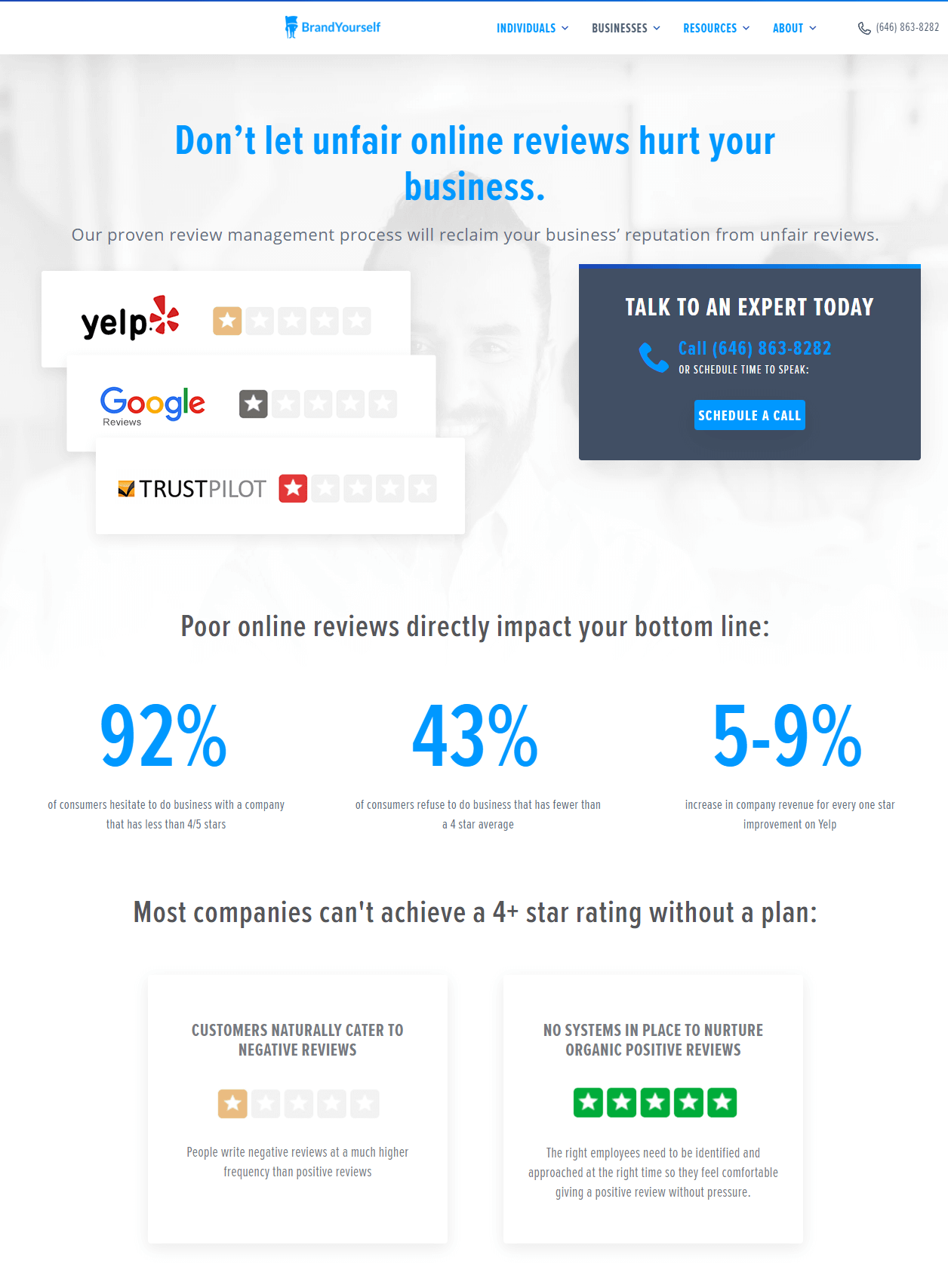
This reality is something most agency clients take for granted. They know they’re at risk, some are aware that things are bad. The truth is, unless they’ve experienced the fallout from negative reviews first hand, most of them are asleep at the wheel.
They don’t know any better.
A consistent stream of negative reviews will put them out of business. This isn’t fear-mongering, it’s math. So you share objective third-party research with them. You show them how to calculate their potential loss, like this:
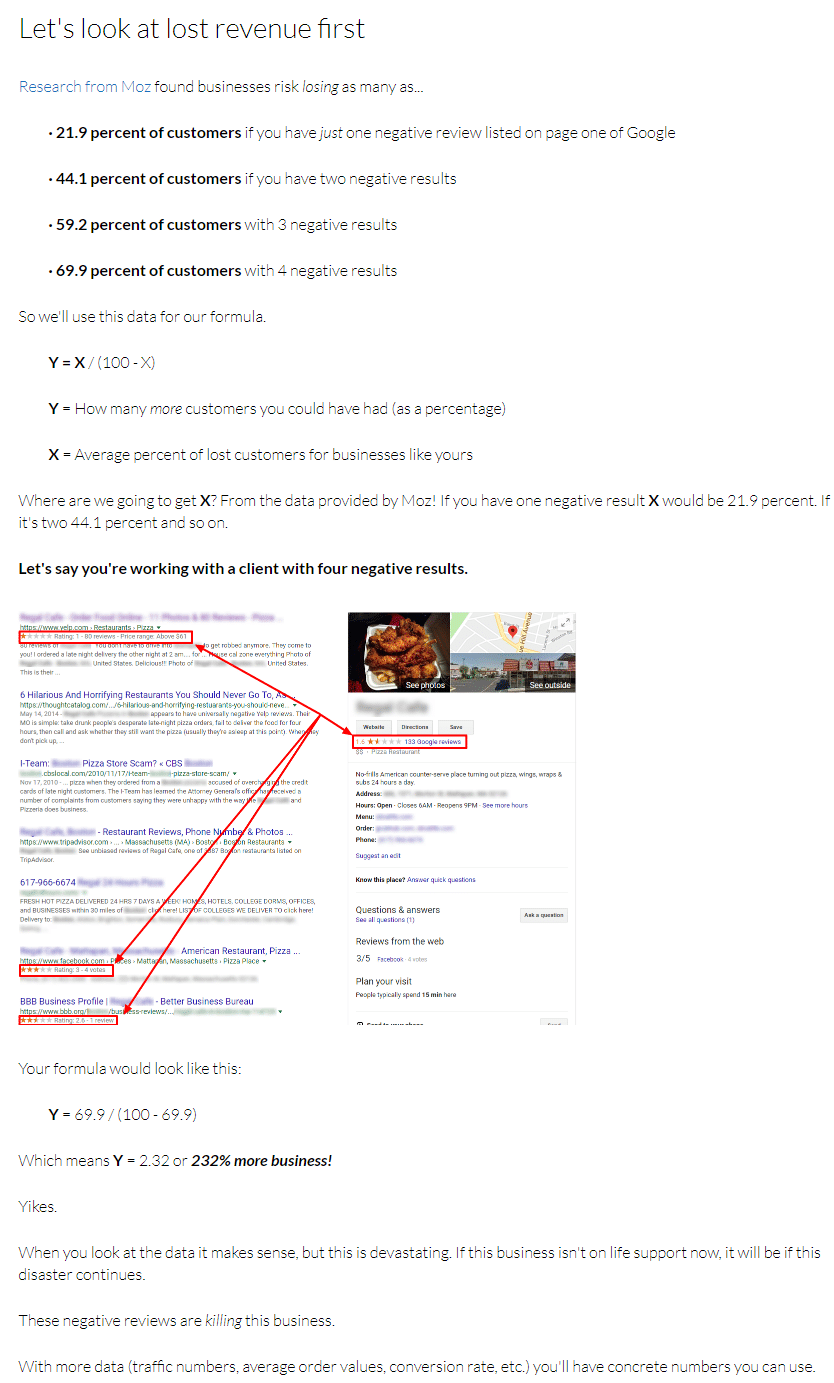
As they calculate the loss for themselves, it slowly dawns on them. Their pain points are actually gaping wounds. Their business is in serious trouble.
This is essential.
If potential clients are in a bad situation, it’s vital that they find out quickly. Even if it’s bad news, it’s good news to know. This is why it’s so important to amplify your client’s problems on your services page. These are the details your clients need to know but won’t get from most of your competitors.
3. Share a compelling value proposition
A compelling value proposition consists of four essential components.
a. Appeal. This is something I (really) want.
b. Exclusivity. I can’t get this thing I want anywhere else.
c. Clarity. I understand you.
d. Credibility. I believe you. I believe your claims.
A strong value proposition is something that’s exclusive, carefully crafted, compelling and believable. Here’s a soft example:
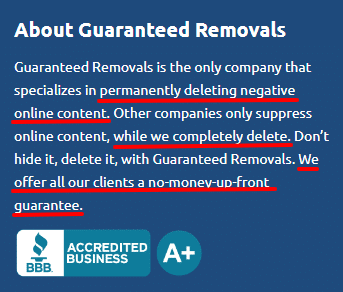
Pretty spicy, no?
This company claims to offer some significant and very compelling benefits. (a.) You don’t pay upfront. (b.) They Don’t Suppress, they delete. (c.) They assume all the risk. (d.) They provide positive reviews and listings to verify their claims.
Sounds impressive.
It seems like they’re able to deliver results consistently. But that’s not the point here, it’s their value proposition. They know their audience. They understand their fear and they assume all the risk.
Now contrast their value proposition with this one.

See what I mean about that? Not as compelling, is it?
You can do better.
Create a value proposition that includes the four ingredients I’ve outlined and you have what you need to attract customer attention automatically.
4. Share your solution to their problems
At first glance, this seems like generic, obvious advice. Advice that isn’t helpful, new or productive.
Ah, but it is.
Because many, many agencies get this component wrong. How do they get this wrong? They focus on the wrong solution. They talk about a problem clients don’t particularly care about.
Wait, what?
That’s right. The vast majority of agencies focus on a problem clients don’t want. Okay, how do you identify a solution your clients want? It’s fairly simple.
You use mirroring.
You mirror the pain points your clients have brought to you. If your clients are flooded with negative reviews that are illegitimate, your solution buries those illegitimate reviews. What if your client’s negative reviews are deserved? You respond to your client’s unhappy reviewers one by one. Here’s how DMA presents that solution on their service page.
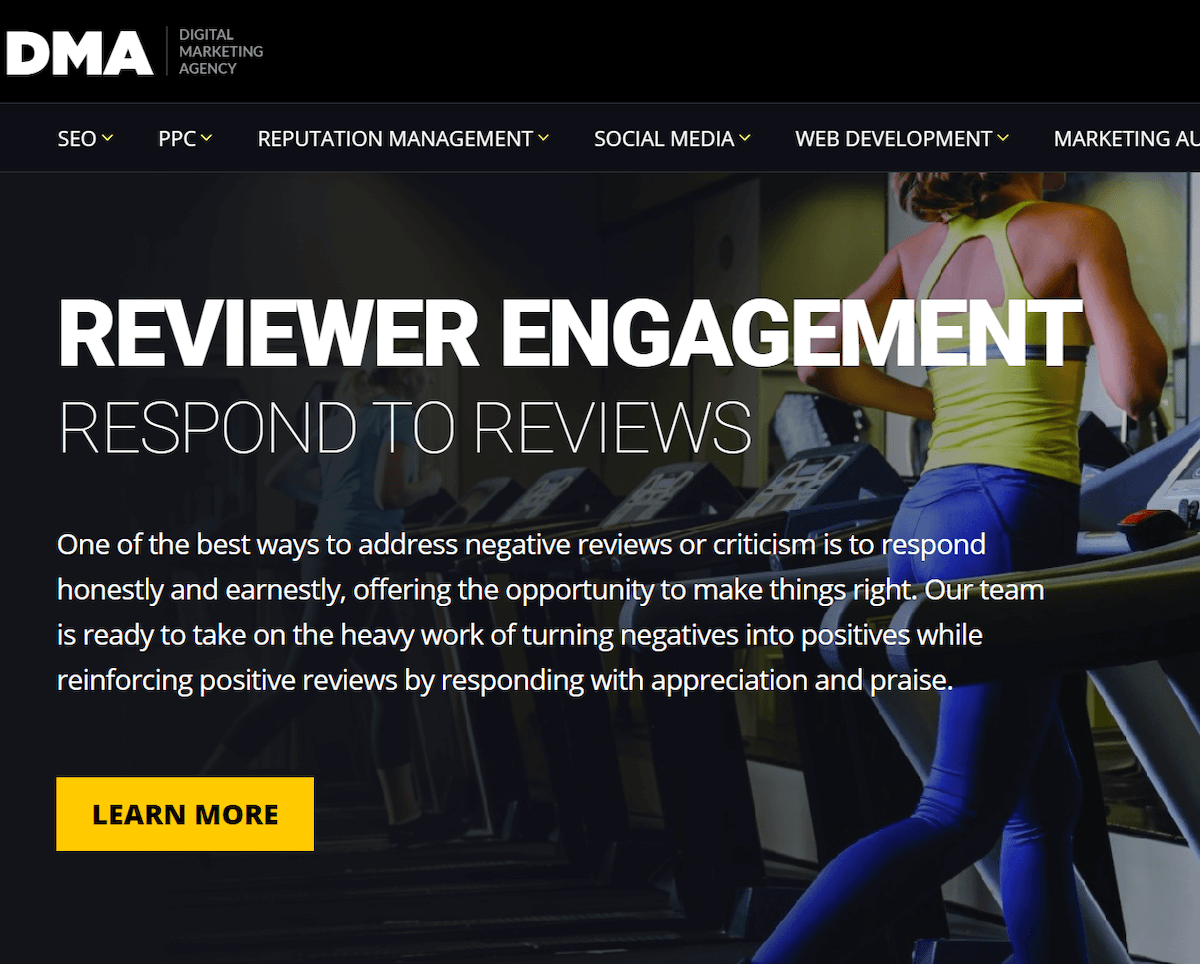
See what I mean?
The solution is tailored to your client’s specific problem. If your client has zero reviews, your solution floods their business with positive reviews.
Here’s why.
- Problems increase stress and anxiety.
- Solutions decrease stress and anxiety.
But that only occurs if the solution mirrors the problem. That’s the goal here. You’re not really selling review management, you’re selling outcomes.
Here’s why mirroring is so important.
Remember earlier, when I mentioned amplifying the problem? When it’s done right, it’s downright frightening for your clients. At some point, your ideal client will sit down and look, really look at the data you’ve shared with them. Once they grasp the full weight of their situation, they’ll realize they’re in over their head.
Your client has three responses.
1. Fear. Your client is overwhelmed by the scenario they’re facing and they choose to take matters into their own hands and do something hasty. This usually makes their problem worse.
2. Freeze. They’re terrified, but they’re also not completely sure about the solution or their ability to resolve their problem. They freeze and decide to do nothing. They avoid the problem as their situation degrades.
3. Flight. They deny that the problem is as serious as you say it is. They deny the evidence presented to them and they avoid the problem.
4. Acceptance. Your clients realize even if you’re delivering bad news, it’s good news to know. They complete the vetting process, review your plan of attack and they retain your agency so the both of you can get to work on resolving their problem.
These options are always available.
This is why amplifying the problem, then mirroring the problem with your solution is so important. It reduces the emotions that produce fear, freeze or flight.
How do we know this is true?
The research tells us.
A research paper by Dariusz Dolinski titled Fear-then-relief argument: How to sell goods using the EDTR technique of social influence, verifies these findings. This was verified in subsequent studies again, and again.
Here’s the surprising part.
This works in reverse! Here’s a quote from the study Emotional Seesaw, Compliance, and Mindlessness:
“This article attempts to recognize certain consequences of those conditions under which the stimuli justifying our experience of such emotional states as fear or joy suddenly disappear. Research done to date by the author and colleagues indicates increased compliance of the subject when addressed with various requests, commands, or suggestions in the situation termed here “emotional seesaw.” The classical “live” example that illustrates this principle is the type of “good cop-bad cop” interrogation procedure. The probable mechanism underlying increased compliance under these conditions is connected with the fact that every emotion generates its own specific behavior program.”
Emphasis added.
Can’t this strategy be misused? Absolutely, which is why it’s so incredibly important that you tell the truth. You tell clients the kind truth on your website, during in-person meetings and in your written communications. You tell the kind truth — even if it means you lose the sale.
This is the antidote to manipulative behavior.
Your client is a scumbag.
That’s the narrative negative reviewers, media outlets and detractors may want to push regarding your clients. When your clients come to you they may be desperate. Or, they may be looking for a preemptive solution.
Insurance if you will.
Your clients may come to you with an urgent problem they’d like you to solve, but that doesn’t mean they’re ready to sign on the dotted line just yet.
They need proof.
They need to see that you’re capable and able to fulfill your promises. They need case studies and social proof. You’re sharp, so you’ve obviously spotted the problem.
You may not be able to share specific details. That would, of course, be harmful to the existing clients in your roster. But it doesn’t mean you can share outcomes. You can share the story anonymously, excluding any personally identifiable or sensitive details. Reach out to clients featured in your case study.
Kind of like this:
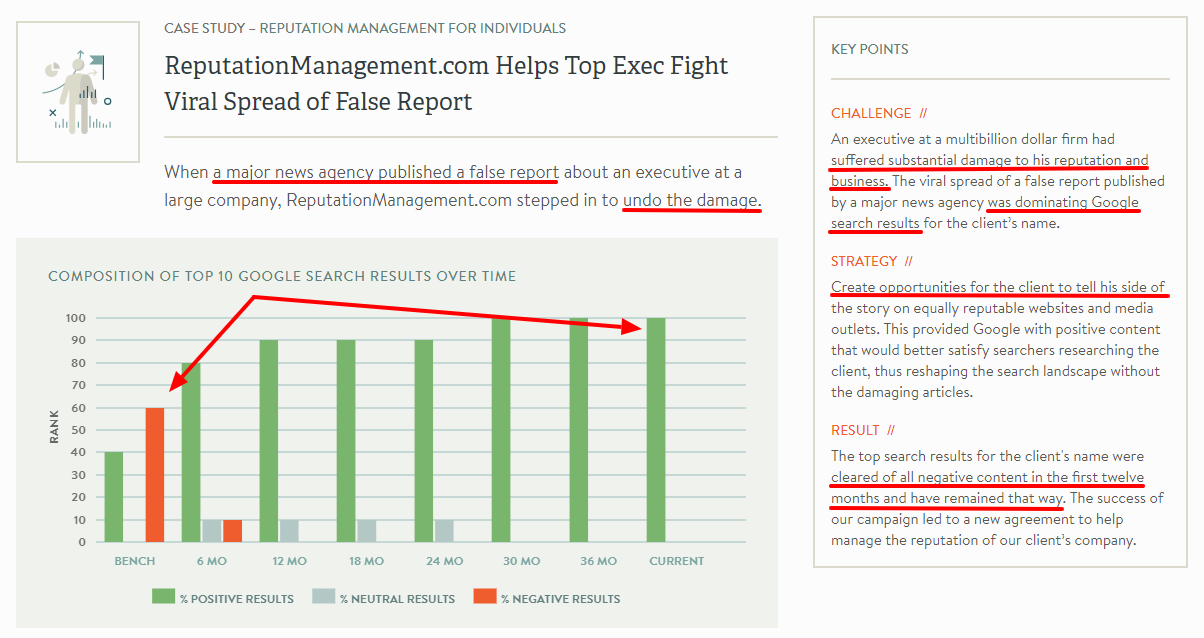
Ask if they’d be willing to share.
Maybe they’re willing to become a reference, maybe they’re okay with you sharing personally identifiable data with an NDA in place.
It can’t hurt to ask.
Then, share your case studies, you know, the ones with anonymized data. Offer to share specific details with serious clients who get in touch.
Here’s an outstanding review management case study example from Reputation X:
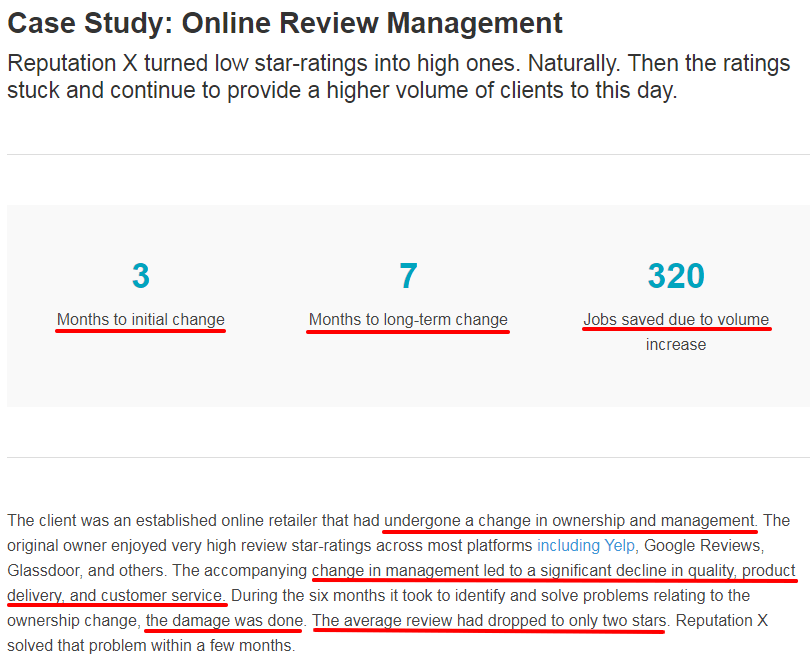
Right out of the gate, we see some fantastic details in the case study listed on their service page.
1. An actionable timeline, i.e., how long you’ll need to wait to see temporary and permanent results
2. Results achieved, they saved 320 jobs due to a dramatic change in reviews (which increased sales volume)
3. A compelling story that explains why their review portfolio took such a drastic hit, how they were affected, and the consequence of their problem (this is amplifying the problem)
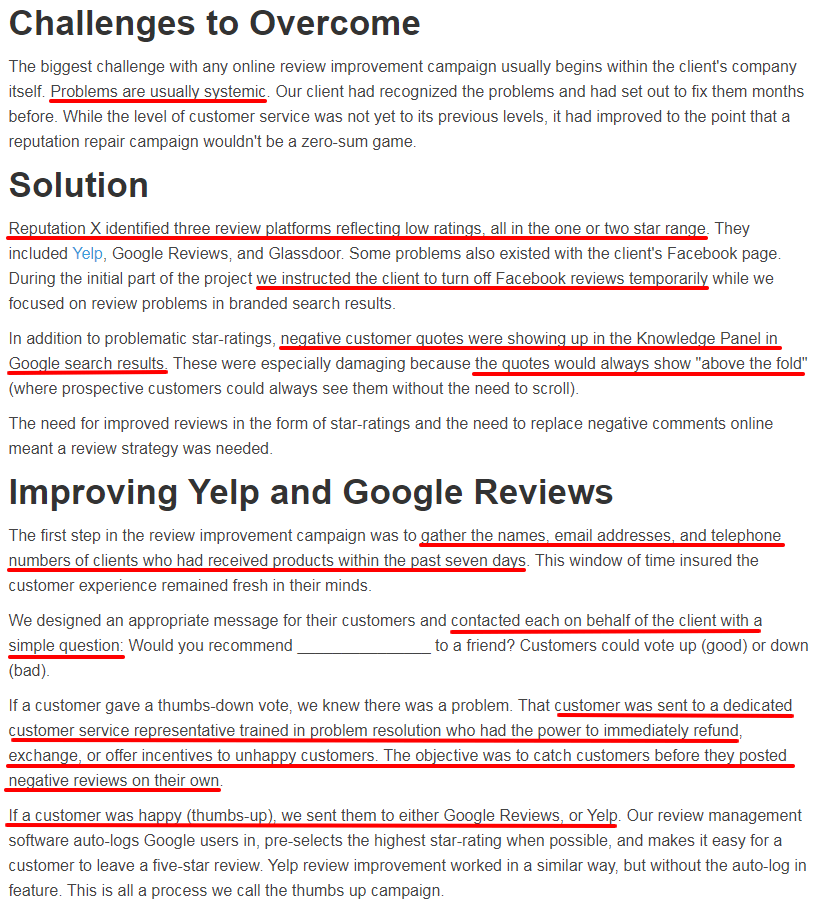
Next, they focused on practical solutions to their client’s problems. Working with their client they:
4. Identified what the problem was, where it was happening (Yelp + Google), and how this problem was presented to customers (knowledge panel and search results in Google)
5. Approached recent customers, via email, with a feeler question, “Would you recommend _______ to a friend?” as a way to gauge their customer experience.
6. Created a simple but carefully implemented plan based on positive or negative customer responses.
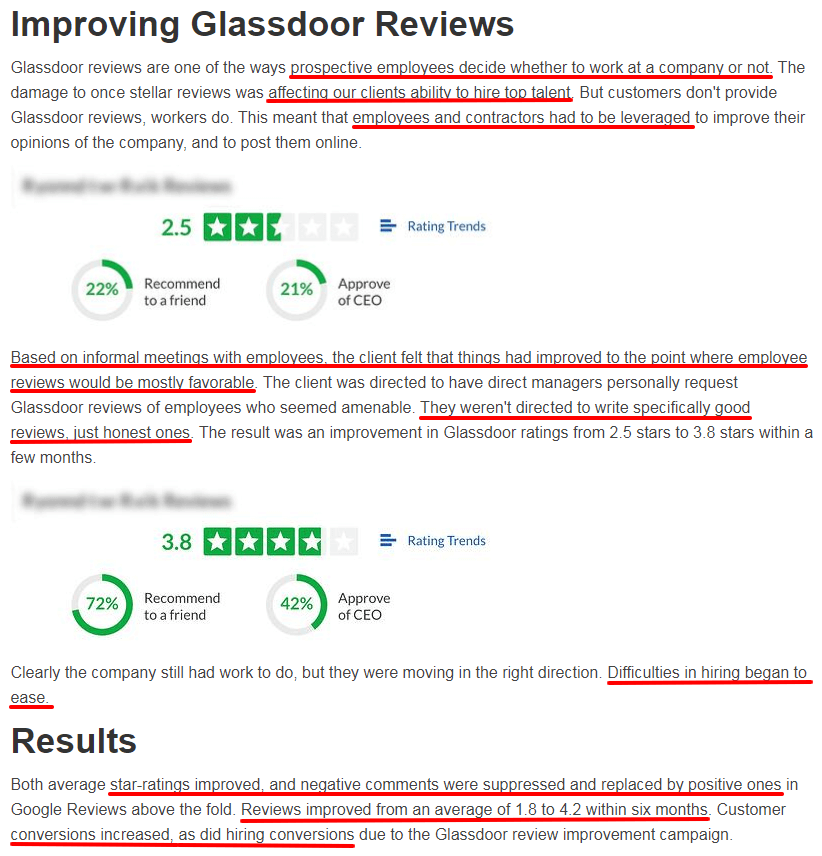
Finally, they asked their clients to approach their employees. They:
7. Conducted informal interviews with employees first, to gauge the effectiveness of their turnaround plan
8. Approached employees and contractors, asking them to advocate on their behalf
9. Asked employees to tell the truth — asking employees to write good reviews would have made the problem much, much worse
10. Tracked the results, sharing the results with their employees and their agency.
Here’s why this works.
These case studies can overcome the problem of anonymity because they rely on specificity. They drill down into the specific details of their client’s situation. They admit fault, showing the initial mistakes that lead to this problem.
This is powerful.
Case studies are compelling on their own when they provide compelling data. Back that up with sensitive data from real people (and legal protection via NDA) and you have the social proof you need.
What if existing clients are iffy?
Show them both versions of the case study (sensitive and anonymized). Give them full control over what’s published and the ability to withdraw consent at any time. Protect them with ironclad NDA’s. Provide a compelling incentive should they choose to share.
6. Futurecast for prospective clients
Clients want you to paint the picture.
Most of the time, you can’t give clients what they really want. An ironclad promise to bury their negative reviews, that you’ll restore their reputation to its unblemished state.
It’s a trap.
They’re desperate to have their problem go away, and they’re more than willing to hang their expectations around your neck. This is where futurecasting comes into play.
It’s managing expectations.
Your clients will come to you with three types of expectations.
- Fuzzy. “I don’t know what I want but I’ll know it when I see it.”
- Implicit. “You know exactly what I want/expect, just get it done.”
- Unrealistic. “I want you to delete every single negative review. I want them to stay gone.”
You’ll need to flush out these expectations, defuse and reset them. How do you do that?
With questions!
Ask existing clients about the fuzzy, implicit and unrealistic expectations they had coming in. Search through discussion boards, forum and blog posts.
Then, discuss them.
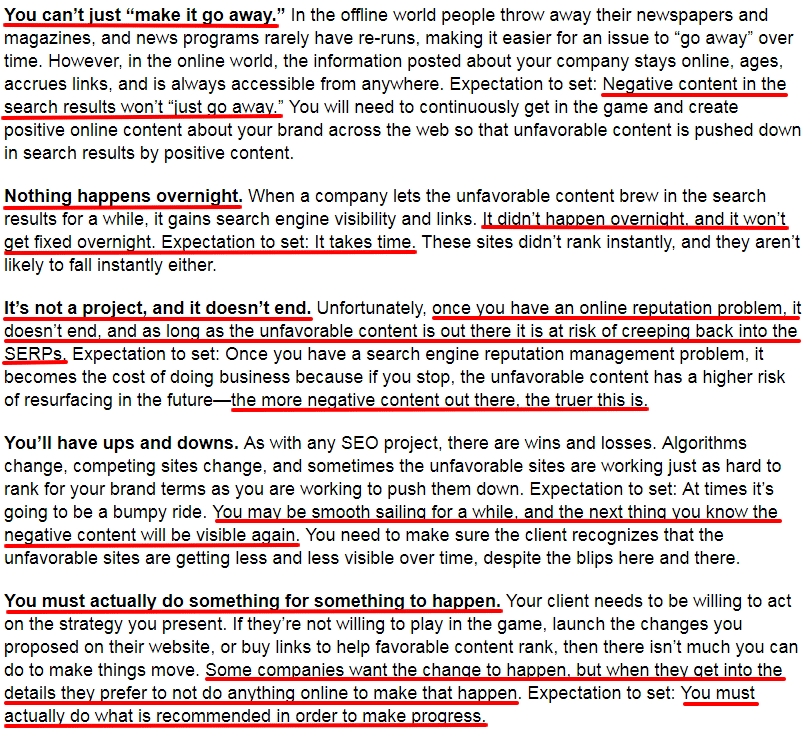
See the fuzzy, implicit and unrealistic expectations lurking in the copy? You want to weave these into your service pages. Use these service pages to defuse these expectations ahead of time. You’ll want to reiterate this during meetings.
Next, discuss outcomes.
Share specific projections and precise details on the outcomes your clients can expect. The goal here is simple: using data, you’ll want to transfer your enthusiasm to your client.
You can fix the problem, and you will.
7. Disqualify the unqualified
Agencies have a disease.
Many of the unpopular review management agencies are desperate. They’re willing to take on any client, anytime, anywhere. Naturally, this leads to unhappy clients – the very same clients who post negative reviews.
The goal is simple.
Your services page should (a.) Disqualify the unqualified and (b.) Qualify the qualified. Your prospects need to earn your time and attention. Your approach should be clear and confident.
Spell it out.
If clients expect an approach or service you don’t provide, let them know.

These examples are a bit abrasive, but that doesn’t mean you have to be. It’s still a smart idea to create content that disqualifies the clients you don’t want.
Why?
It sets the tone for your relationship. Right from the beginning, it creates a dynamic that conveys equality. Doing this means you’re not in a one-down relationship with your clients. You don’t work for them, you work with them.
This has an impact on your reviews.
It’s a self-fulfilling prophecy of sorts. Attract quality clients, and you attract quality reviews. Attract quality reviews and you attract quality clients.
Feed the virtuous cycle you want.
Finally, you’ll need a list of deal-breakers for your agency. When I ran my own agency, there were specific circumstances (above and beyond budget, authority, need, timeline) that qualified as immediate deal-breakers. You’ll need to identify the issues that immediately disqualify a client from the running. Here are a few categories to get you started.
- A plethora of competition. If you're in a bidding war with three or more vendors, things probably aren't going to go in your favor. Your service pages can discourage this kind of behavior by outlining your process (i.e., we only accept clients who meet the following criteria).
- Clients aren't willing to do their part. Clients display this behavior in several ways. (1.) The "just take care of it" clients who expect you to do everything without their involvement (2.) reject everything clients who shoot down your ideas to avoid doing hard work (3.) clients with unrealistic expectations and (4.) time-waster clients.
- Moral or ethical concerns. Many of your review management clients will be desperate. An important consideration to make on your review management services page is the fact that you're unwilling to lie, cheat, manipulate or behave unethically (assuming that this is actually important to you).
Use your service pages to qualify and disqualify the clients that approach your agency.
8. Display a list of the review sites you monitor
Teach your clients.
Show them the 200+ sites you monitor on their behalf. Explain why you monitor these 200+ sites instead of the 600 to 700 sites your competitor claims to monitor.
Whether you offer review monitoring for more or less sites, explain why.
Remember to tell the whole story, give clients a compelling reason. Explain your strategies and tactics. Give them reasons to trust in your expertise.
Pay attention to verticals.
If an attorney reaches out to you, they may have questions about the review sites in their industry. “Do you monitor Avvo, Martindale and LawyerRatingz?” Displaying the logo front and center puts your prospect’s mind at ease.
Don’t just list logos.
Justify them. Explain in just a few words, why the review platforms you monitor make all the difference.
9. Ask for the "tiny yes"
It’s a common mistake.
Agencies ask for large upfront commitments. That’s unfortunate when you realize tiny requests work faster. Initially, clients aren’t too keen on an in-person meeting or extensive phone interview. They know what most agencies are going to do.
Convince them.
Free consultations can be awkward, uncomfortable and kind of gross. Here’s how an average agency does it. They get you on the phone. They learn a little bit about your business, and then KA-BLAM-O!
You’re hit with the hard-sell.
If you’re a client, you know it’s coming. This is exactly why review management clients are afraid to reach out. They don’t want to be sold, but they do want to buy. So what do you do?
You serve.
What does that look like?
You give clients a compelling reason to give you a tiny yes. To share their email, phone number, feedback – anything that moves the relationship forward in a genuine and altruistic way.
Your review management services page attracts or repels
Service pages can be deceiving.
Clients want more than a detailed breakdown of their service offerings. They’re looking for validation — answers to specific questions.
- What can I do here?
- Why should I do it?
- Do you understand my pain?
- Can you fix my problem?
- What’s the first step?
Most agencies aren’t answering these questions, they’re lecturing their clients. They’re providing them with pithy commentary they feel expected to give.
You can be different.
With the right framework, you’ll speak to the right people, using the right voice at the right time. You’ll show clients you understand their pain that you have a solution to their problems.
You don’t need to gamble. There’s no need to guess.
Your framework enables you to tell the whole story. With the right framework, you’ll have everything you need to attract your prospect’s attention automatically, client trust guaranteed.

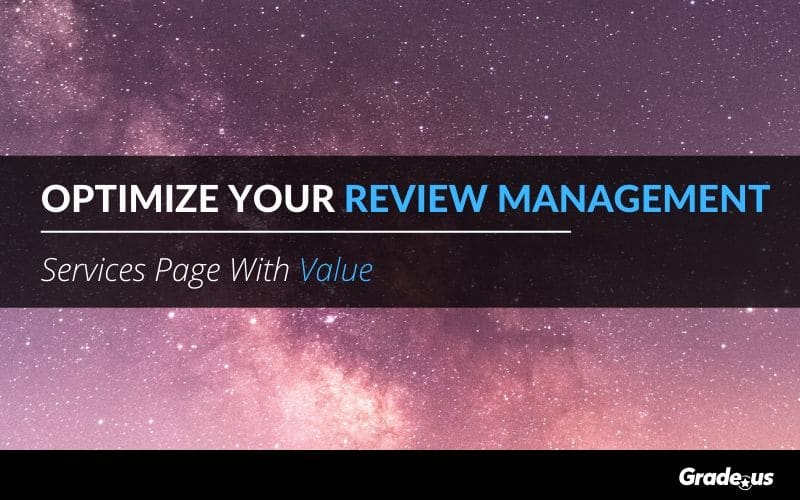




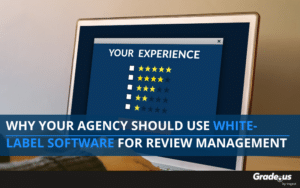



5. Link to case studies, share social proof